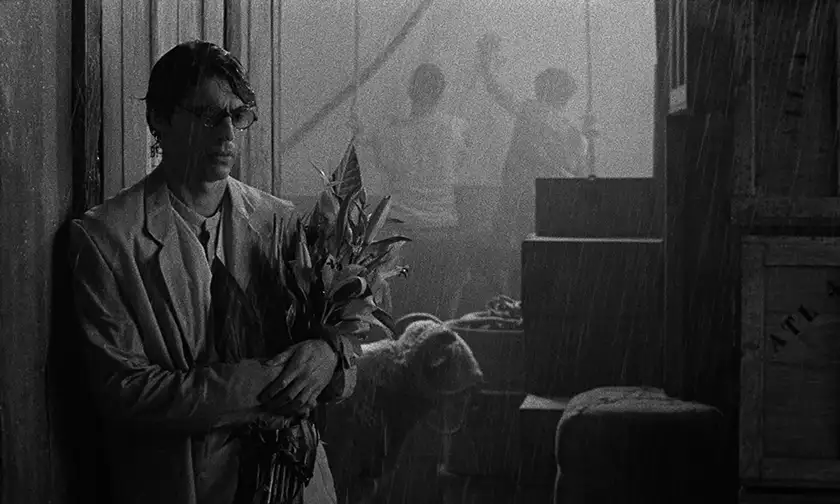Miguel Gomes’ Cannes-prizewinning Grand Tour is a dazzling marriage of past and present, and fact and fiction.
Director: Miguel Gomes
Genre: Drama, History, Romance
Run Time: 129′
BFI London Film Festival Screening: October 13-18, 2024
U.S. Release: March 28, 2025 in theaters
U.K. Release Date: April 18, 2025 on Mubi
When the jury of the Cannes Film Festival garlanded Miguel Gomes with the Best Director award for Grand Tour, it felt like the most deserving award of the night, even allowing for the spectacular choice of giving Anora the Palme d’Or. Grand Tour might be less of a crowdpleaser that Sean Baker’s energetic love story, but it showcases a director in complete control of his craft.
From some very disparate elements he sculpts a unique travelogue, one that exists behind a veil of sadness, and yet still captures the wonder of many wonderful destinations. This, Gomes’ first solo credit as director since 2015’s dreadfully indulgent Arabian Nights trilogy, returns to the dreamy stylishness of Tabu to create an dazzling (but not over-idealised) portrait of a time long past, and the present that followed it.
Long before backpackers took off to Bali in pursuit of consciousness expansion, south-east Asia drew in people in need of escape. However, there are no guarantees that you wouldn’t want to escape further once you get there. The primary narrative thrust of Grand Tour, set in 1918, sees English diplomat Edward (Gonçalo Waddington) flee his posting in Rangoon for Singapore when he gets word that his loving but estranged fiancée Molly (Crista Alfaiate) is coming from London to Rangoon to finally marry him. Gomes sets his story in a specific time and place, but it’s inspired very much by Burma and Asia of the here and now.
The actual opening shot of Grand Tour sees a ferris wheel in present-day Rangoon/Yangon. Besides being ridden and operated by people in modern dress, the wheel is shot in colour, though most of Grand Tour is shot in handsome black and white. Intermittent switching between colour and monochrome is just one filmmaking trick Gomes has up his sleeve to make this movie sing.
The first half of Grand Tour focuses on Edward’s efforts to escape his betrothed, with telegrams from Molly driving him on to the ‘grand tour’ of the title. From Rangoon, he pinballs headlong to Singapore, Bangkok, Japan and China, with no apparent destination. Interspersed among his exploits are scenes from his various stops in their present day form, but almost all of them retain the black-and-white cinematography of Edward’s story. This is apt; it’s hard to pinpoint if Gomes’ script was inspired by the present-day footage, or if he captured that footage to complement this unique story he conceived.
From one scene to another, one might not realize a jump has occurred between timelines until a modern car appears in the background. As Edward flees a royal party in Bangkok while the band plays the Blue Danube, Gomes lets the music continue as he cuts to a motorcycle-heavy traffic jam in the city today. The strains of Strauss sweep the slo-mo bikeriders along in an understated moment of genius.

The style of Grand Tour is what immediately grabs the attention, but it’s not just a marker of a given time or place. The monochrome look (partially captured by acclaimed DoP Sayombhu Mukdeeprom) romanticizes the hotels and palaces of Edward’s story, while countering any risk of exoticizing the modern-day footage. We are only ever given brief views of a city’s skyline before sitting down next to its shopkeepers, musicians, truckers and punters. Grand Tour is a travelogue of escape in its most literal sense. As Edward journeys through forests and hillsides in desperation, the people he meets along the way are not advertisements to encourage tourism. Regretful brides, dismissive monks and pillaging brigands have no time for this Western interloper. Gomes highlights the artifice of Edward and Molly’s story in contrast to the present-day scenes. Much of their exploits are clearly shot on soundstages, and techniques like iris transitions are deployed slyly. The past is the past, and the present is now, but when Gomes stitches them together, both contain wonders.
The second half of Grand Tour shifts its focus to Molly at the start of her journey, arriving in Rangoon only to find she’s just missed her husband-to-be, and thus begins a tour of her own. She has obstacles of her own to contend with on her trip (Marriage proposals, language barriers, illness), though an audience’s investment may waver as Gomes reaches for his conclusion. Grand Tour has a steady and deliberate pace, but as the viewer becomes familiar with Gomes’ modus operandi, the promise of surprises along this journey starts to lessen. That’s not to say Gomes runs out of ideas (Far from it; the film ends on a most unlikely needle drop), but a tighter edit might not have hurt. As it is, though, Grand Tour has plenty of wonders along the road for the open-minded traveller willing to embark on it.
Grand Tour will be screened at the BFI London Film Festival on October 13-18, 2024 and will be released in select US theaters on March 28, 2025. The film will be available to stream on MUBI on 18 April 2025 in the UK and Ireland, Brazil, Mexico, India, Colombia, Turkey, and more territories.

